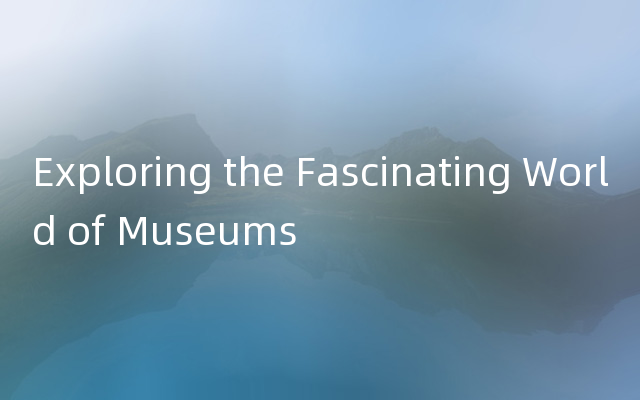
Exploring the Fascinating World of Museums
Introduction:
Museums play an indispensable role in preserving and promoting cultural heritage, scientific advancements, and artistic expressions across the globe. These cultural institutions not only educate and inspire individuals but also foster a sense of unity and understanding among diverse communities. In this article, we will embark on a journey through the enchanting realm of museums, exploring their historical significance, diverse types, and the exceptional collections they house.
1. Historical Significance:
Museums have a rich history dating back to ancient civilizations. The Great Library of Alexandria, established in the 3rd century BCE, can be considered one of the earliest precursors to modern museums. Its purpose was to collect and preserve the knowledge and wisdom of ancient times. Over the centuries, the concept of museums evolved, and today, these institutions have become guardians of human history, showcasing artifacts that provide glimpses into the past.
2. Types of Museums:
There is an astonishing variety of museums around the world, catering to different interests and passions. Natural history museums carry an awe-inspiring collection of fossils, minerals, and taxidermy specimens, educating visitors about the wonders of the natural world. Art museums, on the other hand, house breathtaking masterpieces, showcasing the creativity and ingenuity of renowned artists from different eras. Other notable types include science museums, technology museums, historical museums, anthropological museums, and many more.
3. Preservation and Restoration:
The primary aim of museums is to ensure the preservation and restoration of artifacts and artworks for future generations. Expert curators and conservators work tirelessly to maintain optimal conditions within museum premises. Sophisticated techniques such as temperature control, humidity monitoring, and light exposure management are employed to protect delicate, age-old treasures. Furthermore, advancements in restoration techniques enable museums to revitalize ancient artifacts, ensuring they retain their true essence and aesthetic value.
4. Exhibition Design and Interpretation:
Museums carefully curate exhibitions to engage and educate visitors effectively. Remarkable attention is paid to the design and layout of exhibits, ensuring a seamless flow of information. Creative lighting techniques, interactive displays, and multimedia presentations enhance the learning experience, captivating visitors of all ages. Accompanying interpretive materials, such as audio guides or wall texts, provide further insights into the significance and historical context of the exhibits, enriching the visitors' understanding.
5. Cultural Exchange and Global Outreach:
Museums serve as bridges between different cultures and nations, fostering cultural exchange and international collaboration. Prominent museums worldwide organize traveling exhibitions and loan their collections to other museums, enabling people from various regions to experience diverse cultural heritage. Additionally, in the digital age, many museums have embraced technology to offer virtual tours and online platforms, thereby expanding their reach and making knowledge accessible worldwide.
6. Education and Research:
Education forms a crucial part of a museum's mission. Educational programs, workshops, and guided tours provide invaluable opportunities for students and the public to deepen their knowledge and understanding. Museums also facilitate research by scholars and scientists, granting access to their collections and archives, fueling new discoveries and academic advancements. Consequently, museums contribute significantly to the progress of various fields, including history, art, archaeology, and natural sciences.
Conclusion:
In conclusion, museums exemplify an extraordinary testament to human achievements, cultural diversity, and scientific progress. They serve as invaluable resources for intellectual enrichment, offering us a powerful window into the past and a platform for the exploration of our collective heritage. By nurturing and preserving cultural treasures, museums ensure that future generations can continue to embrace the beauty and wisdom of our world. Let us embrace the wonders of museums and marvel at the sheer richness they have to offer.







